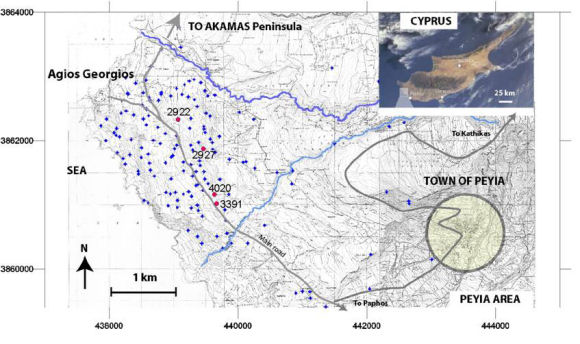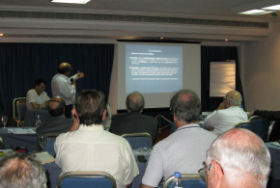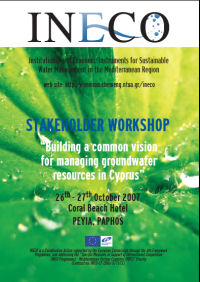|
In this issue:
The Cyprus INECO and Nostrum-DSS Joint Event:
IWRM through coordination, dissemination and
exploitation of research outcomes
Egypt: Meeting local residents in Basandeila
Syria: Discussing with authorities on the pollution of the
Barada River
Lebanon:
Unveiling conflicts & perceptions on water stress in the
Damour River Basin
Cyprus: Citizen proposals for the protection of the Pegeia Aquifer
The 2nd semester Deliverables of INECO
Future project events
The INECO Consortium |
The INECO Cyprus Stakeholder Workshop
Citizen proposals for the protection of the Pegeia Aquifer in Cyprus
|
The Pegeia
Aquifer: A locally important resource |
|
The Pegeia aquifer is situated west of the town of Pafos. It is a phreatic semi-confined
coastal aquifer, developed in a
karstified reef limestone. For a number
of years now, the Pegeia aquifer has
been subjected to intensive overpumping. Although
the aquifer is not yet subject to
dramatic seawater intrusion, degradation
in water quality due to excessive
pumping has already been observed in
some locations.
Considering the rapid increase of water
withdrawals (annual extracted volumes
increased from 0.3 hm³ in 1990 to 0.8
hm³ in 1995 and to 1.3 hm³ in 2000), the
water authorities took measures to
decrease extraction rates, by forcing
local farmers to use surface water.
|
As a result, total
extraction in 2005 was reduced to
approximately 1.1 hm³. Of this
amount, 1 hm³ corresponds to
domestic water supply for the Pegeia
Community and the adjoining tourist
areas, and about 0.1 hm³ for irrigation.
However, the continuing rapid
expansion of the tourism sector, and
the increasing urbanisation of the
region have resulted in a
significant increase of the demand
for potable water. At present, during the high demand season, 0.8%
of consumers (hotels mostly) uses almost
25% of the total freshwater used in
the region.
|
|

The location of the Pegeia
Aquifer
|
Citizen proposals
through the INECO Cyprus
Stakeholder Workshop
|
In the above context, INECO
organized the Cyprus workshop in the
area of Pegeia, on October 26th and
27th 2007. In total, 48 persons attended the workshop,
including local residents and
representatives of citizen movements
(16), representatives of the local
and governmental authorities (10)
and INECO project partners (22).

During the two-day discussions, the
status of the Pegeia aquifer was
discussed in great detail, and
authorities responded to the
comments and questions of citizen
associations of the region.
Identified issues included:
-
Groundwater quality, in terms of
sea-water intrusion, impact of agricultural practices
and problems arising from the lack of a sewerage system.
-
The carrying capacity of the region, in terms of water
supply, as it is considered that existing and foreseen building permits and tourism development exceed the
capacity to provide water in Pegeia and are bound to
result in the
depletion of the aquifer.
-
The seasonal variation in water use, especially in the
hotels of the region, which has major impacts on the
exploitation of the aquifer.
-
The lack of information on water-related issues, and the
lack of a "water culture" among local residents.
|
Suggestions made by citizens and
authorities towards sustainable
exploitation of the aquifer concerned:
-
The implementation of small sewage
treatment units for every house or group of houses. The
recycled water can be used for irrigation of open spaces
and gardens.
- The control over the use of fertilizers and other
chemicals in
agriculture.
- The need to address the potentially significant losses in
the water distribution system
and water over-consumption, especially during the
summer period.
- The reduction of the significant amount of potable water
abstracted from the aquifer which is used in hotel
units, possibly through the adoption of small-scale
desalination for meeting tourist demand.
- The need for optimization in the monitoring of the water table and
groundwater salinity evolution.

More information...
|
|

|
|



